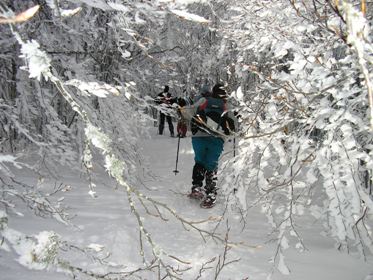
 Weekend in the Casentinesi forest
Weekend in the Casentinesi forest

filled by Giulia

The National Park of Casentino Forests, Mount Falterona and Campigna, established in 1993, covers an area of about 36,000 hectares, divided equally between Emilia Romagna and Tuscany, including the provinces of Forlì, Cesena, Arezzo and Florence.
It’s one of the most precious and ancient forest areas of Europe, rich in history, flora and fauna go along with the snowshoes in the winter is a unique experience, irrespective of any close encounters, only the luckiest , with the wolf of the northern Apennines, or wild boar, deer and roe deer.
Among villages, parishes, monasteries and convents have passed through the centuries the saints and knights, merchants and pilgrims.
The first to settle in these areas were the Etruscans, who in Falterona Mountain, in the locality of Lago degli Idoli, have left the most significant archaeological site of all the Tuscan Romagna.
It’s from these lush forests that has been taken the prescious timber for the scaffolding of the Duomo in Florence or the long straight beams to build the ships of the fleet of Pisa.
Writers of all time were fascinated by these places, who quotes from Dante Alighieri's Divine Comedy in the beauties of the poet Dino Campana, who traveled on foot most of the territory by narrating the journey in the famous Orphic songs.
From the strong emotions aroused by the poets in the wilderness to the most intimate that inspired the saints: Francis, who came to La Verna and “sul crudo sasso” received the stigmata and Romuald at Camaldoli, which laid the foundation of his hermitage.
Both sides, Tuscany and Emilia are equally impressive.
From Prataglia Badia, in the province of Arezzo, leave the trails for tours
Mounte Penna, which offers a breathtaking panorama of the Lama forest, at Camaldoli, in Fangacci to Crocina Pass, past the atmospheric Buca delle Fate.
For several consecutive hours walking in the countryside through pine fir and white pine blacks, hardwood forests and beech forests.
From Campigna, instead, on the Romagna region, the pitch of the Calla, where according to tradition, Hannibal spent time during his descent into Italy and then climb to Monti Falco, Falterona and Gabrendo and walks among the beech woods, immersed in an atmosphere fairytale, between branches laden with snow
In the town is the former surveillance forest house, already documented in the sixteenth century and now converted into a hotel. Also visit the small museum local forestry
On the way back, at the end of the weekend, you have to stop in La Verna, where, perched on the steep southern face of Monte Penna, the famous Franciscan monastery, nestled in a quiet and dark forest of maple, ash, elm and beeches.
|
|






















